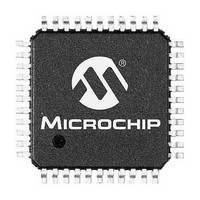PIC24FV32KA304-I/PT Microchip Technology, PIC24FV32KA304-I/PT Datasheet - Page 137

PIC24FV32KA304-I/PT
Manufacturer Part Number
PIC24FV32KA304-I/PT
Description
MCU 32KB FLASH 2KB RAM 44-TQFP
Manufacturer
Microchip Technology
Specifications of PIC24FV32KA304-I/PT
Processor Series
PIC24FV
Core
PIC
Data Bus Width
16 bit
Program Memory Type
Flash
Program Memory Size
32 KB
Data Ram Size
2 KB
Maximum Operating Temperature
+ 85 C
Mounting Style
SMD/SMT
Package / Case
TQFP-44
Development Tools By Supplier
MPLAB IDE Software
Minimum Operating Temperature
- 40 C
Lead Free Status / Rohs Status
Lead free / RoHS Compliant
Available stocks
Company
Part Number
Manufacturer
Quantity
Price
Company:
Part Number:
PIC24FV32KA304-I/PT
Manufacturer:
VISHAY
Quantity:
12 000
Company:
Part Number:
PIC24FV32KA304-I/PT
Manufacturer:
Microchip Technology
Quantity:
10 000
- Current page: 137 of 320
- Download datasheet (3Mb)
10.5
Generally, changing clock speed and invoking one of
the power-saving modes are the preferred strategies
for reducing power consumption. There may be
circumstances, however, where this is not practical. For
example, it may be necessary for an application to
maintain uninterrupted synchronous communication,
even while it is doing nothing else. Reducing system
clock speed may introduce communication errors,
while
communications completely.
Doze mode is a simple and effective alternative method
to reduce power consumption while the device is still
executing code. In this mode, the system clock
continues to operate from the same source and at the
same speed. Peripheral modules continue to be
clocked at the same speed, while the CPU clock speed
is reduced. Synchronization between the two clock
domains is maintained, allowing the peripherals to
access the SFRs while the CPU executes code at a
slower rate.
Doze mode is enabled by setting the DOZEN bit
(CLKDIV<11>). The ratio between peripheral and core
clock speed is determined by the DOZE<2:0> bits
(CLKDIV<14:12>).
configurations, from 1:1 to 1:128, with 1:1 being the
default.
It is also possible to use Doze mode to selectively reduce
power consumption in event driven applications. This
allows clock-sensitive functions, such as synchronous
communications, to continue without interruption. Mean-
while, the CPU Idles, waiting for something to invoke an
interrupt routine. Enabling the automatic return to
full-speed CPU operation on interrupts is enabled by
setting the ROI bit (CLKDIV<15>). By default, interrupt
events have no effect on Doze mode operation.
2011 Microchip Technology Inc.
using
Doze Mode
a
power-saving
There
are
mode
eight
may
possible
PIC24FV32KA304 FAMILY
stop
10.6
Idle and Doze modes allow users to substantially
reduce power consumption by slowing or stopping the
CPU clock. Even so, peripheral modules still remain
clocked, and thus, consume power. There may be
cases where the application needs what these modes
do not provide: the allocation of power resources to
CPU processing, with minimal power consumption
from the peripherals.
PIC24F devices address this requirement by allowing
peripheral modules to be selectively disabled, reducing
or eliminating their power consumption. This can be
done with two control bits:
• The Peripheral Enable bit, generically named,
• The Peripheral Module Disable (PMD) bit,
Both bits have similar functions in enabling or disabling
its associated module. Setting the PMD bit for a module
disables all clock sources to that module, reducing its
power consumption to an absolute minimum. In this
state, the control and status registers associated with
the peripheral will also be disabled, so writes to those
registers will have no effect, and read values will be
invalid. Many peripheral modules have a corresponding
PMD bit.
In contrast, disabling a module by clearing its XXXEN
bit, disables its functionality, but leaves its registers
available to be read and written to. Power consumption
is reduced, but not by as much as the PMD bits are
used. Most peripheral modules have an enable bit;
exceptions include capture, compare and RTCC.
To achieve more selective power savings, peripheral
modules can also be selectively disabled when the
device enters Idle mode. This is done through the control
bit of the generic name format, “XXXIDL”. By default, all
modules that can operate during Idle mode will do so.
Using the disable on Idle feature disables the module
while in Idle mode, allowing further reduction of power
consumption during Idle mode, enhancing power
savings for extremely critical power applications.
“XXXEN”, located in the module’s main control
SFR.
generically named, “XXXMD”, located in one of
the PMD Control registers.
Selective Peripheral Module
Control
DS39995B-page 137
Related parts for PIC24FV32KA304-I/PT
Image
Part Number
Description
Manufacturer
Datasheet
Request
R

Part Number:
Description:
Manufacturer:
Microchip Technology Inc.
Datasheet:

Part Number:
Description:
Manufacturer:
Microchip Technology Inc.
Datasheet:

Part Number:
Description:
Manufacturer:
Microchip Technology Inc.
Datasheet:

Part Number:
Description:
Manufacturer:
Microchip Technology Inc.
Datasheet:

Part Number:
Description:
Manufacturer:
Microchip Technology Inc.
Datasheet:

Part Number:
Description:
Manufacturer:
Microchip Technology Inc.
Datasheet:

Part Number:
Description:
Manufacturer:
Microchip Technology Inc.
Datasheet:

Part Number:
Description:
Manufacturer:
Microchip Technology Inc.
Datasheet:











